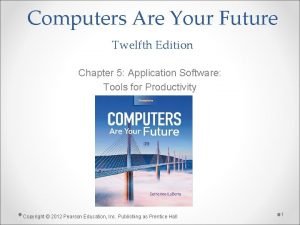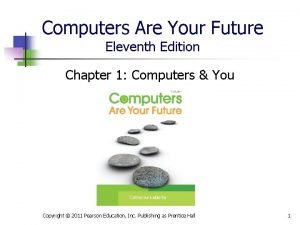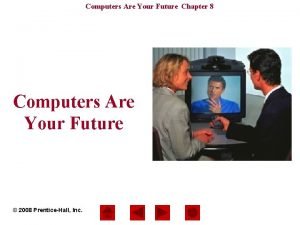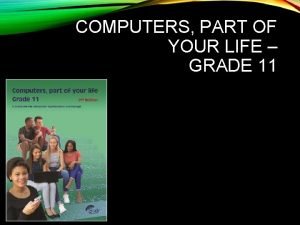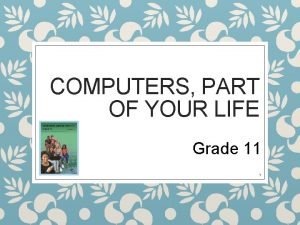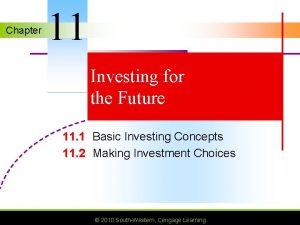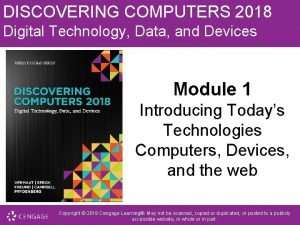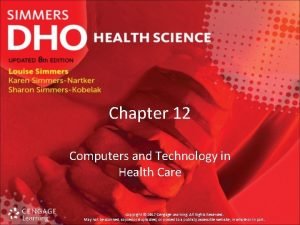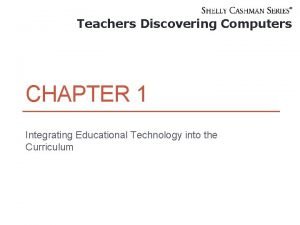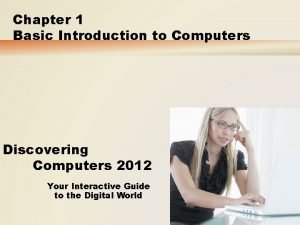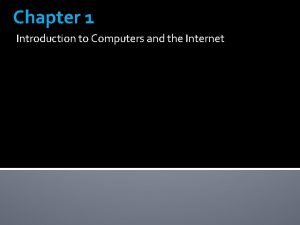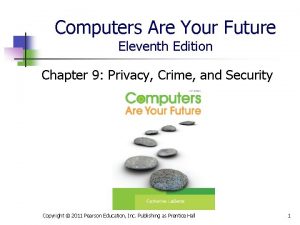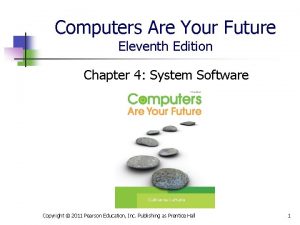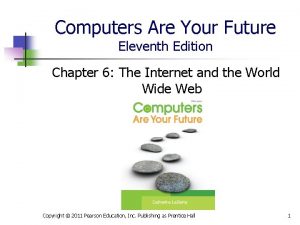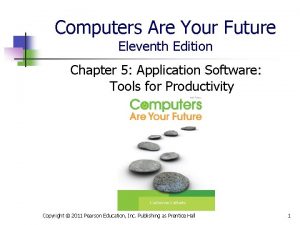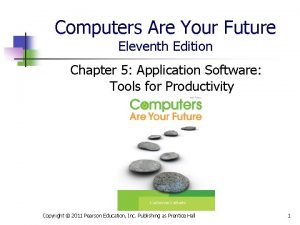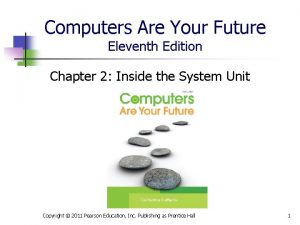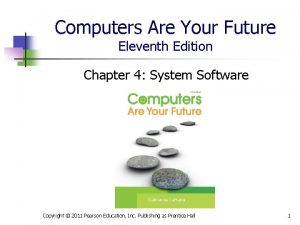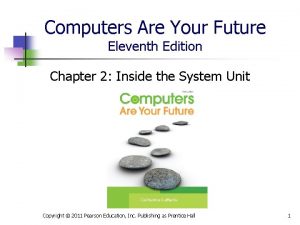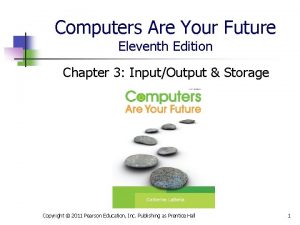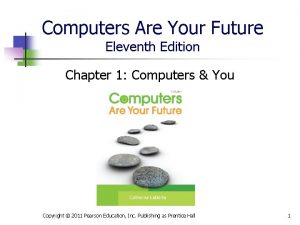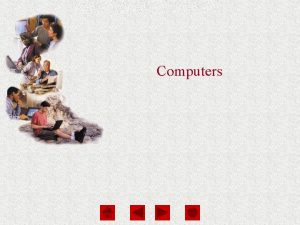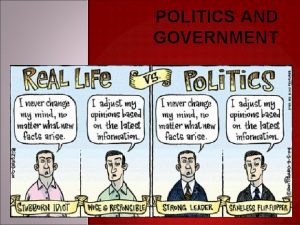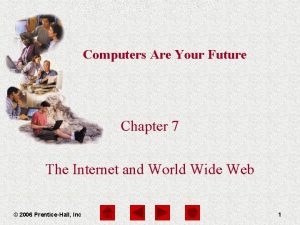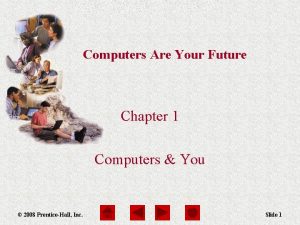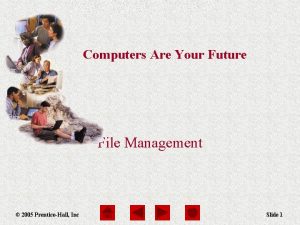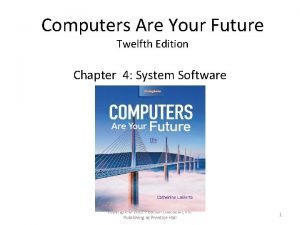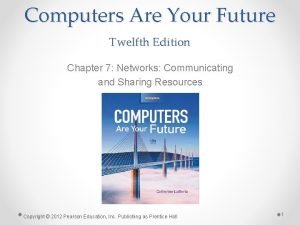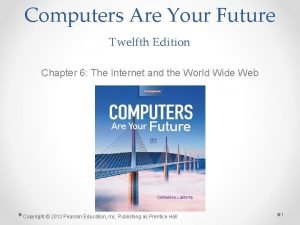Computers Are Your Future Eleventh Edition Chapter 6



























- Slides: 27

Computers Are Your Future Eleventh Edition Chapter 6: The Internet and the World Wide Web Copyright © 2011 Pearson Education, Inc. Publishing as Prentice Hall 1

How the Internet Works n n The Internet is a universal system of computers and networks. Cyberspace, a term used to refer to the Internet, is the unlimited span of networks using the same data exchange methods. Copyright © 2011 Pearson Education, Inc. Publishing as Prentice Hall 2

The Internet and the Web: What’s the Difference? n The World Wide Web, also known as the Web or WWW: n n Contains billions of documents Is a portion of the Internet Uses the Internet as a means to transport information Is a separate entity from the Internet Copyright © 2011 Pearson Education, Inc. Publishing as Prentice Hall 3

The Internet and the Web: What’s the Difference? n n The Web contains the information. The Internet transports information to and from users. Copyright © 2011 Pearson Education, Inc. Publishing as Prentice Hall 4

The Internet and the Web: What’s the Difference? n n n A Web page is a document that may include text, graphics, sound, animation, and video. A Web site is a collection of Web pages. A Web browser is a program that displays Web pages and linked items. Copyright © 2011 Pearson Education, Inc. Publishing as Prentice Hall 5

The Internet and the Web: What’s the Difference? n n n Hyperlinks or links are words and images that bring other documents into view when clicked. Hypertext uses links to move to additional related information. Hypertext Markup Language (HTML) uses tags to specify how a Web page should display. Copyright © 2011 Pearson Education, Inc. Publishing as Prentice Hall 6

The Internet and the Web: What’s the Difference? n The most popular Web browsers n n n Mozilla Firefox Google Chrome Internet Explorer Opera Safari Copyright © 2011 Pearson Education, Inc. Publishing as Prentice Hall 7

The Internet and the Web: What’s the Difference? n n Web sites and their associated information are stored on computers called Web servers are used to recognize information requests, process the requests, and send the requested documents. Copyright © 2011 Pearson Education, Inc. Publishing as Prentice Hall 8

The Internet and the Web: What’s the Difference? n n Every device connected to the Internet, including PCs and servers, is given a unique network identifier called an Internet Protocol (IP) address. The identification of an Internet resource’s type and location is performed through its Uniform Resource Locator (URL). Copyright © 2011 Pearson Education, Inc. Publishing as Prentice Hall 9

The Internet and the Web: What’s the Difference? n The complete URL is made up of the Hypertext Transfer Protocol (HTTP), domain name, path, and resource name. Copyright © 2011 Pearson Education, Inc. Publishing as Prentice Hall 10

The Internet and the Web: What’s the Difference? n Ways to access a Web page n n Type a URL into the address bar. Click a tab in the browser window. Click a hyperlink. The history list compiles a list of the Web pages that the user has visited. Copyright © 2011 Pearson Education, Inc. Publishing as Prentice Hall 11

The Internet and the Web: What’s the Difference? Copyright © 2011 Pearson Education, Inc. Publishing as Prentice Hall 12

The Internet and the Web: What’s the Difference? n n Downloading is the process of transferring a file or document from one computer to the user’s computer. Uploading is the process of transferring a file or document from the user’s computer to another computer. Copyright © 2011 Pearson Education, Inc. Publishing as Prentice Hall 13

Finding Information on the Web n A subject guide, where Web pages are grouped under specific headings, is offered by some search sites. Copyright © 2011 Pearson Education, Inc. Publishing as Prentice Hall 14

Finding Information on the Web n Search engines index databases of Web pages to enable fast information searches. Copyright © 2011 Pearson Education, Inc. Publishing as Prentice Hall 15

Finding Information on the Web n n Specialized search engines index information such as job advertisements, and names and addresses. Some Web site home pages include portals, which provide organized subject guide links to topics such as the news, local weather, and e-mail. Copyright © 2011 Pearson Education, Inc. Publishing as Prentice Hall 16

Finding Information on the Web n Example of a portal Copyright © 2011 Pearson Education, Inc. Publishing as Prentice Hall 17

Finding Information on the Web n n n Search operators are used to perform complex searches. Inclusion operators, generally a plus sign (+), are used so that only Web pages including those criteria are retrieved. Exclusion operators, generally a minus sign (-), are used so that only Web pages excluding those criteria are retrieved. Copyright © 2011 Pearson Education, Inc. Publishing as Prentice Hall 18

Finding Information on the Web n n Wildcard symbols, such as ? and *, replace the zero or additional characters in search words to improve search accuracy. In phrase searching, the user places quotation marks around a phrase to create a complete unit for search purposes. As a result, search engines retrieve only those sites that contain the exact phrase. Copyright © 2011 Pearson Education, Inc. Publishing as Prentice Hall 19

Exploring Internet Services n n Electronic mail (e-mail) is a type of application software that makes sending and receiving messages through computer networks possible. An e-mail attachment is a computer file included with an e-mail message. Copyright © 2011 Pearson Education, Inc. Publishing as Prentice Hall 20

Exploring Internet Services n n An e-mail address, a unique cyberspace address for each individual, consists of a user name, the name of the hosting email service, and the top-level domain. Unsolicited e-mails received by users, usually from advertisers, are called spam. Do not open spam. Copyright © 2011 Pearson Education, Inc. Publishing as Prentice Hall 21

Exploring Internet Services n File Transfer Protocol (FTP) is a method used to transfer files over the Internet. n n n Use when files are too large to attach to e -mails. Avoid sending sensitive material to an anonymous FTP site. Use to upload Web pages. Copyright © 2011 Pearson Education, Inc. Publishing as Prentice Hall 22

E-Commerce n n E-commerce is the conducting of business through the use of networks or the Internet. Business-to-Business (B 2 B) ECommerce refers to a business providing supplies to other businesses via the Internet. Copyright © 2011 Pearson Education, Inc. Publishing as Prentice Hall 23

E-Commerce n n Consumer-to-Consumer (C 2 C) ECommerce refers to the exchange of business between individuals. e. Bay is a good example. Business-to-Consumer (B 2 C) ECommerce refers to shopping online rather than at a physical store. Copyright © 2011 Pearson Education, Inc. Publishing as Prentice Hall 24

E-Commerce n Online Shopping Shop for good deals. n Use shopping portals such as Price. Grabber. com to compare prices and products. n Look for coupons and rebates. n Copyright © 2011 Pearson Education, Inc. Publishing as Prentice Hall 25

E-Commerce Copyright © 2011 Pearson Education, Inc. Publishing as Prentice Hall 26

E-Commerce n Other Growth Areas n n Travel reservations Banking Copyright © 2011 Pearson Education, Inc. Publishing as Prentice Hall 27
 Computers are your future 12th edition pdf
Computers are your future 12th edition pdf Antigentest åre
Antigentest åre Eleventh edition management
Eleventh edition management Eleventh edition management
Eleventh edition management Management eleventh edition
Management eleventh edition Management eleventh edition stephen p robbins
Management eleventh edition stephen p robbins Computers are your future
Computers are your future Computers are your future
Computers are your future Future continuous and future perfect simple
Future continuous and future perfect simple Future perfect simple continuous
Future perfect simple continuous Eleventh 5 year plan
Eleventh 5 year plan Eleventh 5 year plan
Eleventh 5 year plan Eleventh plan
Eleventh plan For his eleventh birthday elvis presley
For his eleventh birthday elvis presley Using mis 10th edition
Using mis 10th edition Using mis (10th edition) 10th edition
Using mis (10th edition) 10th edition Computers part of your life grade 11 memo
Computers part of your life grade 11 memo Computers part of your life grade 11 memo
Computers part of your life grade 11 memo Put and take account
Put and take account Give us your hungry your tired your poor
Give us your hungry your tired your poor Discovering computers 2018 chapter 1 ppt
Discovering computers 2018 chapter 1 ppt Chapter 12 computer and technology in health care
Chapter 12 computer and technology in health care Discovering computers 2018 chapter 1
Discovering computers 2018 chapter 1 Discovering computers 2018 chapter 1
Discovering computers 2018 chapter 1 Chapter 1 introduction to computers and programming
Chapter 1 introduction to computers and programming Chapter 1 introduction to computers and programming
Chapter 1 introduction to computers and programming Chapter 1 introduction to computers
Chapter 1 introduction to computers Chapter 1 introduction to computers and programming
Chapter 1 introduction to computers and programming
